15 Types of Bushy and Shrub-Like Palm Trees

Bushy and shrub-like palm trees are excellent for landscaping gardens. Compact palm shrubs with bushy fronds add lush evergreen foliage and a tropical charm to gardens. These small palm trees require minimal maintenance, offer shade, and thrive in various climates. You can use them to create a vibrant and inviting space, making them excellent for tropical aesthetic appeal and landscaping practicality.
Palm trees are generally known for their tall stature, sometimes growing over 100 ft. (30 m) tall. However, palm shrubs are more suited to landscaping around the home. Bushy palm trees typically grow between 3 and 10 ft. (1 – 3 m) tall. They also have a slow to moderate growth rate, meaning they take many years to reach their mature size.
This article has descriptions and pictures of various types of bushy and shrub-like palm trees. You will learn about the different characteristics and growth habits of these palm trees, helping you choose the best variety for your landscaping needs.
Bushy and Shrub-Like Palm Trees
Palms with a bushy or shrub-like appearance are characterized by feather-like or fan-like fronds. Palms like the lady palm, areca palm, and dwarf palmetto have a clumping appearance of feathery or palmate fronds. The European fan palm is a large, hardy, multi-stemmed shrub-like palm with fan-shaped leaves.
Low-growing, bushy palm shrubs are ideal for landscaping because they don’t take up much space and provide tropical, evergreen foliage. You can use the aesthetic appeal of shrub-like palms for privacy screening, shade, or creating a focal point. Their drought tolerance means they require minimal care when established.
Types of Bushy and Shrub-Like Palm Trees
Let’s look in detail at some of the most popular types of bushy and shrub-like palm trees. Descriptions of the bushy palms and information about their growing requirements will help you choose the best ones for your landscape.
Lady Palm (Rhapis excelsa)
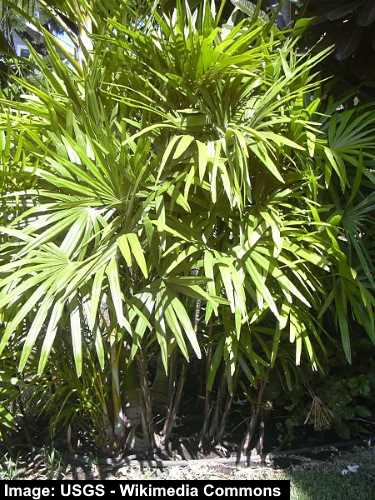
Lady palms are known for their bushy appearance, with large fan-shaped fronds growing on multiple stems. The palm’s dark green leaves grow in a dense, clumping habit. The palm fronds grow 20” (50 cm) long and have five to ten narrow, oblong lobes. It blooms in summer with clusters of small yellow flowers.
Planted in mass, bushy lady palms create a windbreak, privacy screen, or foundation planting. The shrub-like palms are easy to grow in partial sun or full shade, making them highly versatile landscaping plants. Although tolerant of drought, they require regular watering when growing in full sun.
Lady palms also tolerate low light conditions, making them a great choice for growing potted palms for indoor spaces with limited sunlight. Growing in containers, they can add a tropical touch to the home.
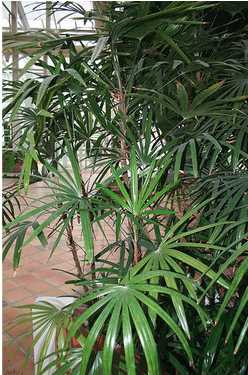
The lady palm is a multi stem tree that you can grow at home as a potted plant
- USDA Growing Zones: 9 to 11
- Sun Exposure: Partial sun, dappled sunlight, full shade
- Mature Size: 6 to 15 ft. (1.8 – 4.6 m) tall
Cat Palm (Chamaedorea cataractarum)
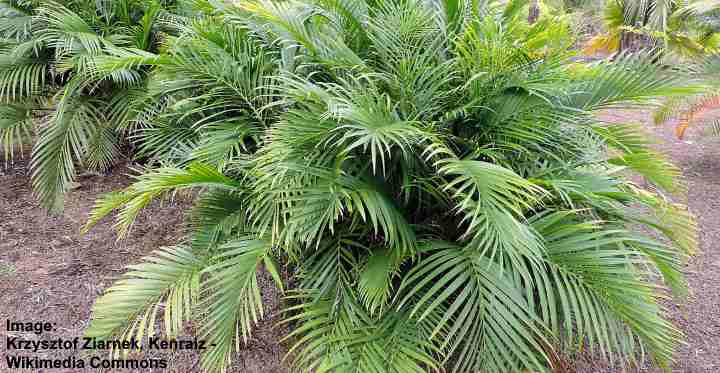
Cat palms are small, attractive, clumping palms with a bushy tropical look. The palm’s shrub-like growth is due to its densely growing multiple canes with large, arching feather-like fronds. These palm leaves have a graceful arching growth habit, growing up to 3 ft. (1 m) long with thin strap-like leaflets.
Cat palms grow in the ground up to 6.5 ft. (2 m) tall and 8 ft. (2.4 m) across. The small, attractive, bushy palm is useful in landscaping as a privacy screen, windbreak, evergreen hedge, or tropical accent in gardens and patios. Cat palms are some of the most shade-tolerant species from the genus Chamaedorea.
- USDA Growing Zones: 9 to 11
- Sun Exposure: Partial sun or full shade
- Mature Size: 6 ft. (1.8 m) tall and up to 8 ft. (2.4 m) wide
Pygmy Date Palm (Phoenix roebelenii)

The slow growing pygmy date palms have a bushy appearance when they are young (left). Right image: a mature pygmy date palm
Pygmy date palms are small, elegant palm trees with a bushy crown of finely textured, arching fronds. Typically, small, bushy, pygmy date palms have a solitary trunk. Still, their compact size and graceful appearance make them popular for landscaping. The elegant crown consists of feathery, arching fronds growing up to 3 ft. (1 m) long.
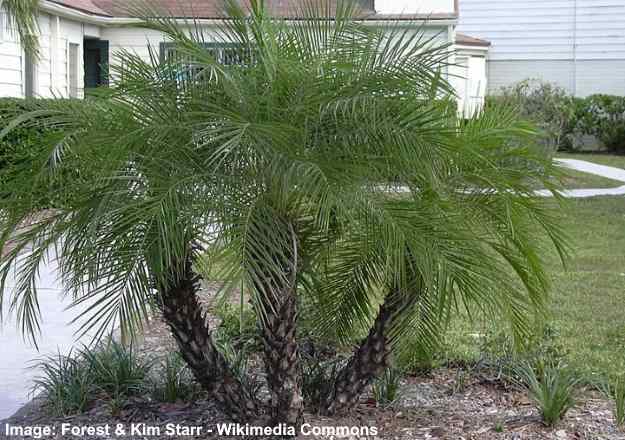
In landscaping a garden the pygmy date palms are often planted as a clump, and then the trunks tend to bend to the sides, creating a decorative focal point
Pygmy date palms grow up to 10 ft. (3 m) tall. They are slow-growing palms; therefore, they will have a compact, low-growing, bushy appearance for several years. Easy to grow, the plant is popular for growing as an accent plant or focal point in smaller sub-tropical gardens.
These palms are relatively low-maintenance and can tolerate a wide range of growing conditions if they get enough sunlight and regular watering.
- USDA Growing Zones: 9 to 11
- Sun Exposure: Full sun to partial shade
- Mature Size: 6 to 10 ft. (1.8 – 3 m) tall and up to 8 ft. (2.4 m) wide
Mazari Palm (Nannorrhops ritchiana)

Mazari palms are small, slow-growing palms with a compact, bushy appearance. These palms have distinctive bluish-green fan-shaped fronds with deeply divided lobes, making them look spiky. The cold-hardy palms have a clustering habit and grow as mounding shrubs. However, some Mazari palms grow as tall, single-trunked trees.
Mazari palms are native to the arid regions of the Middle East and Asia. They are highly tolerant of dry and hot conditions. The drought-tolerant palms are ideal for xeriscaping and arid landscapes. However, they are also exceedingly cold-hardy down to 5°F (-15°C).
Landscaping ideas for bushy shrub-like Mazari palms include foundation planting, bushy hedges, privacy screens, or containers to add exotic beauty to patios.
- USDA Growing Zones: 7 to 11
- Sun Exposure: Full sun
- Mature Size: 10 to 20 ft. (3 – 6 m) tall and a wider spread
European Fan Palm (Chamaerops humilis)
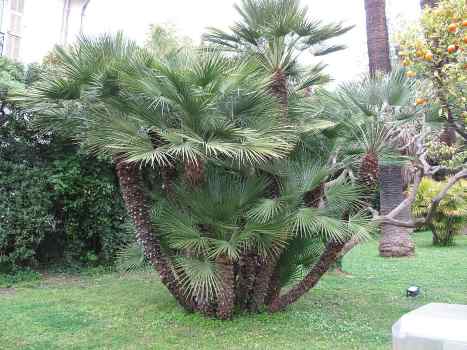
European fan palms are small, bushy, evergreen palms with a dense crown of large fan-shaped leaves. The leaves have up to 20 narrow, stiff segments up to 24” (60 cm) long. These palmate leaves grow at the end of 4 ft. (1.2 m) spiny petioles.
Bushy European fan palms can have up to eight trunks, each with a rough texture. Due to its compact, clumping habit, the slow-growing palm is ideal for landscaping smaller gardens. Additionally, the palms are cold-hardy and drought-tolerant and thrive in poor soils. European fan palms can be used as a focal point in gardens or as a border plant.
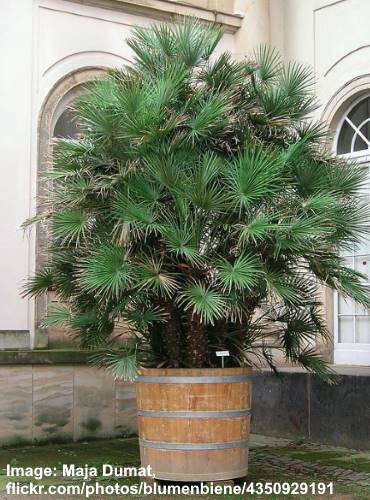
The European fan palm can be grown as a potted palm
- USDA Growing Zones: 9 to 11
- Sun Exposure: Full sun to partial shade
- Mature Size: 6 to 15 ft. (1.6 – 4.5 m) tall and up to 20 ft. (6 m) wide
Needle Palm Tree (Rhapidophyllum hystrix)
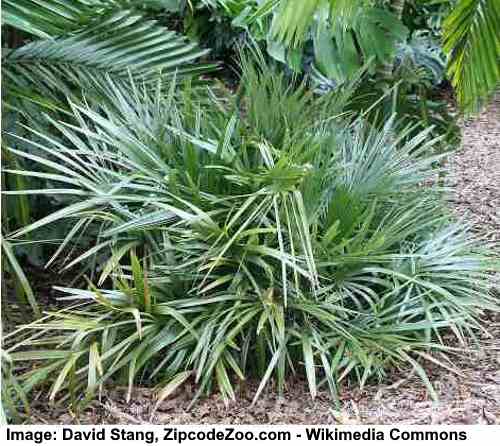
Needle palms are known for their shrubby, rounded habit with large palmate fronds. The slow-growing palms have stiff leaf sheaths with sharply pointed tips. Also, sharp, needle-like spines cover its trunk and stems. The low-growing bushy palm grows up to 6 ft. (1.8 m) tall, forming dense, impenetrable clumps.
The needle palm tree’s fan-shaped leaves grow in a circular pattern. The needle-like spines make the small palm ideal as a security barrier, evergreen privacy hedge, or foundation planting. They also tolerate drought, heat, and cold temperatures, making them a hardy, versatile choice for landscaping.
- USDA Growing Zones: 6 to 10
- Sun Exposure: Full sun, partial shade, or deep shade
- Mature Size: 3 to 6 feet (1.8 – 2.4 m) tall and 4 to 8 ft. (1.2 – 2.4 m) wide
Dwarf Sugar Palm (Arenga engleri)
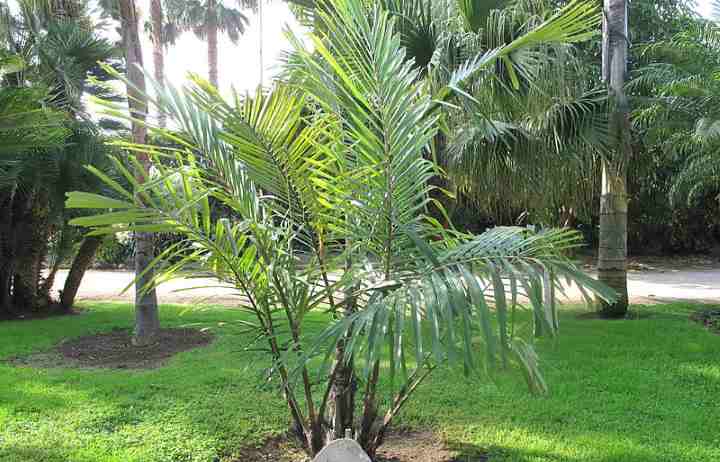
Dwarf sugar palms have a clustering nature that helps to create a dense, bushy appearance in landscapes. Features of the small, compact palm are its multiple stems, feathery fronds growing up to 8 ft. (2.4 m) long, and clusters of colorful, sweet-smelling flowers.
Dwarf sugar palms are versatile landscaping plants tolerant of various soil conditions. In tropical climates, you can grow dwarf sugar palms as accent plants or in a line to create an evergreen hedge or screen. They also go by the names Formosa palm or Taiwan sugar palm.
- USDA Growing Zones: 10 and 11
- Sun Exposure: Full sun or partial shade
- Mature Size: Up to 10 ft. (3 m) tall and 16 ft. (4.8 m) wide
Saw Palmetto (Serenoa repens)

Saw palmetto is a small, shrub-like palm native to the southeastern United States. The palm can develop a bushy appearance thanks to its fan-shaped leaves with sharp, saw-like teeth along the edges. The palm grows in a clumping habit, forming dense thickets with blue-green or silvery-white foliage.
Saw palmetto palms grow up to 10 ft. (3 m) tall and wide. Their attractive, bushy foliage is ideal as a textural accent or foundation planting in warmer climates. They also naturalize well and are useful as evergreen ground cover in seaside or coastal landscapes due to their salt tolerance.
- USDA Growing Zones: 8 to 11
- Sun Exposure: Full sun, partial shade, or deep shade
- Mature Size: 5 to 10 ft. (1.5 – 3 m) tall and wide
Dwarf Palmetto (Sabal minor)
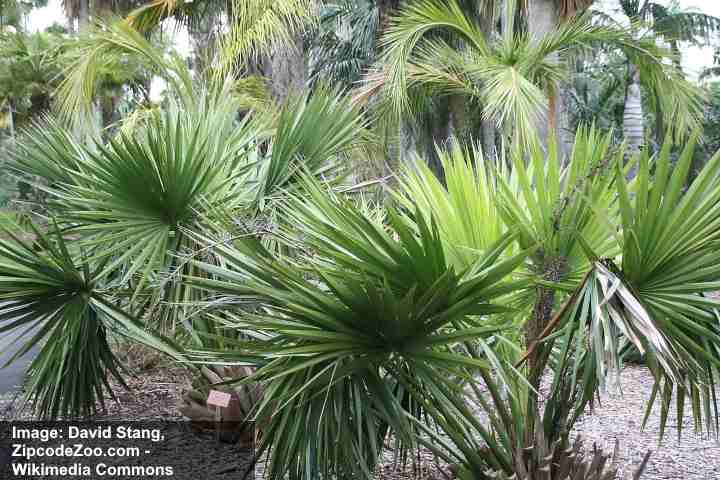
Dwarf palmetto can be found in many habitats and is a cold hardy small palm
Dwarf palmetto has the potential to grow into a bushy clump because of its suckering nature and huge, fan-shaped leaves. A characteristic of the palm is its long petioles with huge, spiky leaves, 3 ft. (1 m) in diameter. These fronds have up to 40 narrowly pointed segments.
Dwarf palmetto blooms in summer with large clusters of white flowers followed by dark brown fruits. The slow-growing palm grows up to 6 ft. (1.8 m) tall. This hardy plant tolerates various soil types, including sandy and clay soils. It can also perform well in dry landscapes or damp, partially shaded sites.
- USDA Growing Zones: 7 to 10
- Sun Exposure: Full sun to partial shade
- Mature Size: 4 to 6 ft. (1.2 to 1.8 m) tall and wide
Parlor Palm (Chamaedorea elegans)
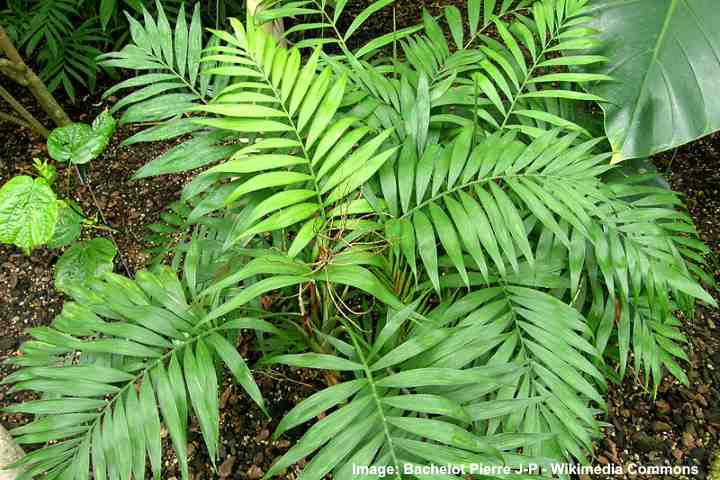
Parlor palms have a shrub-like bushy appearance due to their large, densely growing feathery fronds. The compact, bushy palms have a single trunk with arching green pinnate leaves with large lanceolate leaflets. Growing up to 6 ft. (1.8 m) tall, they thrive in dappled sunlight or shade, growing in moist soils.
In warmer locations in USDA zone 10 and above, the outdoor bushy palms are ideal for planting as accent plants, ground cover in dappled sunlight, an informal hedge, or to add a tropical textural element in borders.
Due to their cold intolerance, parlor palms are often used as decorative accents in homes, offices, and other indoor spaces. They grow well in containers in low-light places. They are ideal for adding greenery to indoor environments that get little sunlight.

A potted parlor palm grown as a houseplant
- USDA Growing Zones: 10 to 12
- Sun Exposure: Indirect sunlight, partial shade, or heavy shade
- Mature Size: 2 to 6 ft. (1.2 to 1.8 m) tall and up to 3 ft. (1 m) wide
Bamboo Palm (Chamaedorea seifrizii)

Bamboo palms—also called reed palms—have a clustering nature, giving them a bushy appearance. The gray-silver or green fronds have up to 15 pairs of pointed strap-like leaflets. These grow on multiple, long arching stems, creating a dense, bushy appearance in landscapes. Related to the parlor palm, the clumping bamboo palm is ideal for shaded locations.
Bamboo palms get their name from the cane-like stems resembling slender bamboo. The palm’s bushy nature makes it ideal for growing as a privacy screen, hedge, or tropical accent. It requires relatively moist soil and high humidity to perform well in gardens.
In cooler climates, bamboo palms make excellent houseplants. Their low-light tolerance means they thrive in rooms with very little natural sunlight.

Bamboo palms grown as houseplants give a tropical look to any indoor space
- USDA Growing Zones: 10 to 12
- Sun Exposure: Partial sun or dappled sunlight
- Mature Size: 8 to 12 ft. (2.4 – 3.6 m) tall and up to 8 ft. (2.4 m) wide
Areca Palm (Chrysalidocarpus lutescens or Dypsis lutescens)
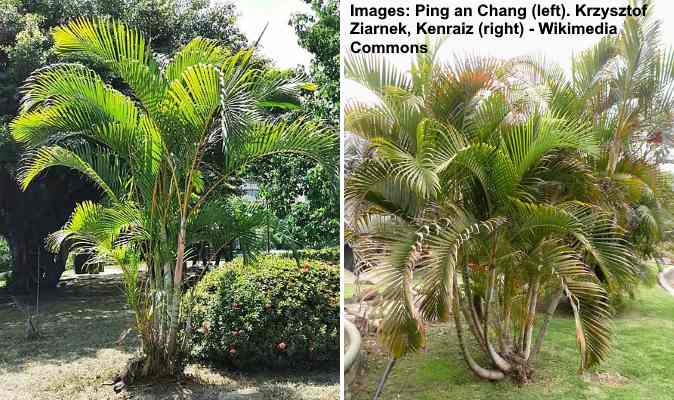
The areca palm has a bushy appearance when young (see right image)
Areca palms are known for their compact, long, arching leaves and multiple stems, giving them a dense, bushy appearance. The palm is characterized by upward arching fronds growing 6.5 to 10 ft. (2 – 3 m) tall. These give the palm tree a distinctive vase shape.
Attractive areca palms bloom in summer with clusters of yellow flowers followed by yellow-orange fruits. The bushy palms also go by the names “bamboo palm,” “butterfly palm,” and “golden feather palm.” However, other types of palms also have these common names.
It’s good to note that the palm loses its dense, bushy appearance as it grows taller.
Areca palms are versatile palms in tropical landscapes. They work well as a focal point in a garden, as a dense privacy screen growing in groups, or for shade around patios or pool areas. Areca palms are also popular potted palms for indoors.
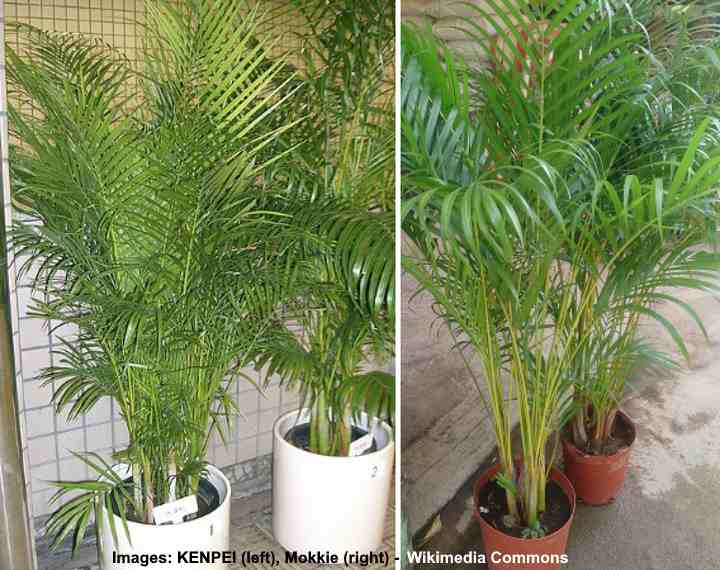
Areca palms grown as indoor plants
- USDA Growing Zones: 10 and 11
- Sun Exposure: Full sun, dappled sunlight, or partial shade
- Mature Size: 10 to 30 ft. (3 – 9 m) tall and 8 to 15 ft. (2.4 – 4.5 m) wide
Sago Palm (Cycas revoluta)
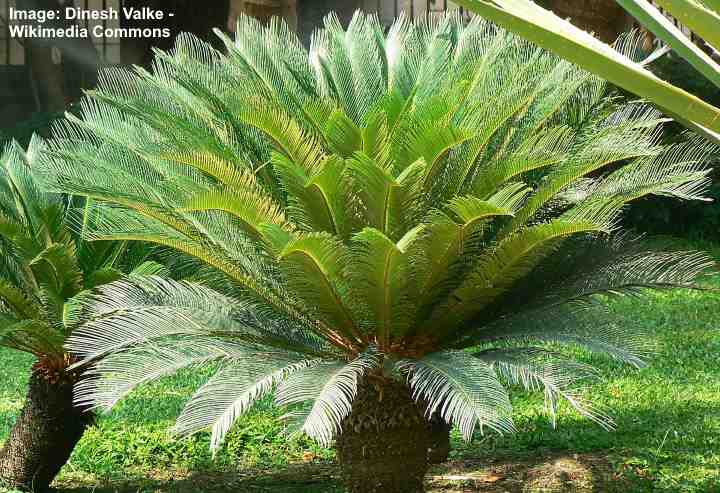
Sago palms are not true palms but are called palms due to their bushy palm-like appearance. The slow-growing plants have a dense, bushy appearance when young. Their foliage consists of glossy, arching pinnate leaves growing up to 5 ft. (1.5 m) long.
Because of their slow growth, sago palms take many years to reach a mature height of 10 ft. (3 m). Their attractive appearance makes them ideal ornamental plants in tropical gardens and landscapes. Indoors, the palms perform well in containers and keep their bushy appearance as the pot restricts their growth.
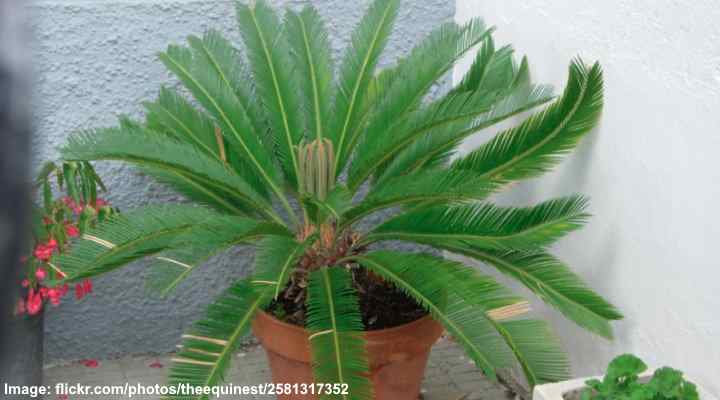
A potted sago palm plant
- USDA Growing Zones: 9 to 11
- Sun Exposure: Partial shade
- Mature Size: 3 to 10 ft. (1 to 3 m) tall and wide
Coontie Palm (Zamia pumila)

The coontie palm is known for its thick clumps of fern-like leaves that grow in a dense, bushy manner. The evergreen tropical plant grows up to 3 ft. (1 m) tall and has large, stiff, pinnately compound leaves up to 4 ft. (1.2 m) long. These fronds have five to 30 pairs of leaflets.
Native to Florida, the coontie palm is a cycad, not a true palm. It tolerates drought and salt spray, making it ideal for landscaping coastal gardens. Thanks to their low, bushy growth, coontie palms are ideal for foundation planting, lining driveways, or as specimen plants.
- USDA Growing Zones: 7 to 10
- Sun Exposure: Full sun or partial shade
- Mature Size: 1 to 3 ft. (0.3 – 1 m) tall and wide
Cardboard Palm (Zamia furfuracea)
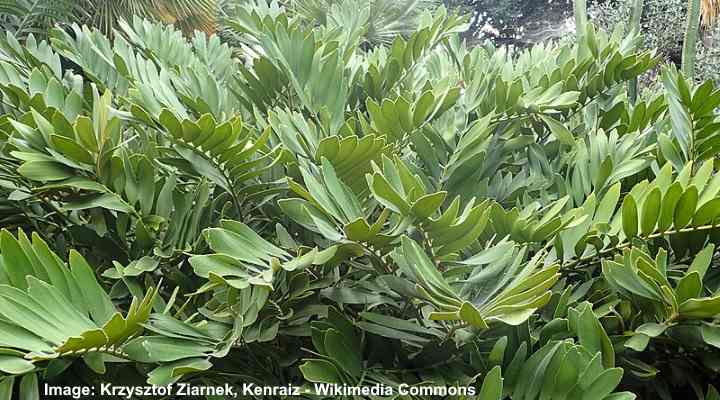
Cardboard palms may resemble low-growing bushy palms but are short cycads with arching pinnate leaves growing in a rosette pattern. The leaves grow up to 5 ft. (1.5 m) long, and the oval leaflets can grow 8” (20 cm) long. A unique feature of the plant is the thick, stiff leaves—hence the name “cardboard palm.”
Cardboard palms are well-suited for growing in tropical and subtropical garden landscapes. They are drought-tolerant and can withstand a wide range of temperatures. These shrub-like “palms” perform well in containers on porches, balconies, or decks, or as ground cover for dry areas, or a border plant.
- USDA Growing Zones: 9 to 11
- Sun Exposure: Full sun to partial shade
- Mature Size: 3 to 5 ft. (0.9 to 1.5 m) tall and up to 7 ft. (2.1 m) wide.
Related articles:
